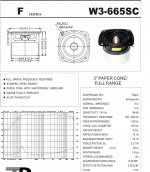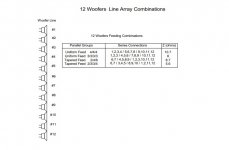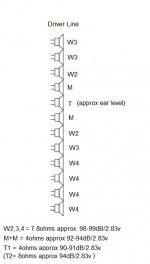I have a pair of 12 driver (shaded)line arrays using Tang Band 3" drivers that have problems with failing treble response on and off axis (due to driver response and comb filtering). Otherwise I really like the sound, esp. in the midrange.
I'm looking to add a tweeter. I have a nice extended-sounding pair of Infinity Emit-k on hand already (I also have a pair of PT2C-8, but they're huge). I tried the Emits with a simple, series cap, and liked what they added(but the breakup of the TB's was still there).
I was thinking of removing one 3" driver (at ear level), replacing with the Emit tweeter. But that probably won't be a good sensitivity match. So another approach waits
Any recommendations?
🙂 Thank for any ideas,
-Charles
I'm looking to add a tweeter. I have a nice extended-sounding pair of Infinity Emit-k on hand already (I also have a pair of PT2C-8, but they're huge). I tried the Emits with a simple, series cap, and liked what they added(but the breakup of the TB's was still there).
I was thinking of removing one 3" driver (at ear level), replacing with the Emit tweeter. But that probably won't be a good sensitivity match. So another approach waits
Any recommendations?
🙂 Thank for any ideas,
-Charles
Last edited:
After reading Jim Griffin's paper, I'm experimenting with wiring series sets of drivers in parallel to steer the loudness towards ear level.
I appreciate your thoughts.
-Charles
I appreciate your thoughts.
-Charles
Last edited:
I don't know exactly what you mean by that, but a design may offer a certain in room power balance. It sounds as though you want to focus on the direct sound?
Unless I'm misinterpreting the point of shading an array, can't the shading arrangement of full range drivers on the baffle
be used to advantage for both direct sound and the room response? For instance, if we wire a 4,3,3,2, then use the divers with the greatest intensity near ear level (which puts the lower level drivers closer to the floor and ceiling?
Thanks for helping me to better understand.
-Charles
be used to advantage for both direct sound and the room response? For instance, if we wire a 4,3,3,2, then use the divers with the greatest intensity near ear level (which puts the lower level drivers closer to the floor and ceiling?
Thanks for helping me to better understand.
-Charles
You don't change both the room and the direct.. you only change the relationship between them. The direct can be equalised, therefore when you reconfigure the speakers you think you are changing the direct, but you are actually changing the room power.
Ok.
Then how does the different impedance of the various series sets of drivers help? I was assuming it affected the loudness of each group (i.e. the "2" would be louder than the "3", which would be louder than the "4"). If not, how does this apparent "voltage divider" of series/parallel drivers work?
Thanks again,
-Charles
Then how does the different impedance of the various series sets of drivers help? I was assuming it affected the loudness of each group (i.e. the "2" would be louder than the "3", which would be louder than the "4"). If not, how does this apparent "voltage divider" of series/parallel drivers work?
Thanks again,
-Charles
The drivers I'm using are Tang Band W3-665SC (data sheet attached), and the
method of wiring (series/parallel) is suggested by Jim Griffin on pages 20-22 of his paper:
Design Guidelines for Practical Near Field Line Arrays
I've been playing around with 4,3,3,2 and 4,3,2 configurations, where 4 drivers in series are 32ohms, 3 are 24 ohms, and two are 16 ohms, with the series sets wired in parallel to get a usable net impedance. I understand that this steers more power to the lower impedance sets(?).
Please let me know what other if you need.
Thanks,
-Charles
method of wiring (series/parallel) is suggested by Jim Griffin on pages 20-22 of his paper:
Design Guidelines for Practical Near Field Line Arrays
I've been playing around with 4,3,3,2 and 4,3,2 configurations, where 4 drivers in series are 32ohms, 3 are 24 ohms, and two are 16 ohms, with the series sets wired in parallel to get a usable net impedance. I understand that this steers more power to the lower impedance sets(?).
Please let me know what other if you need.
Thanks,
-Charles
Attachments
Last edited:
I plan to place the tweeter in the spot where driver #5 is shown (basically, at ear level, while seated).
If I were to flank it with the sets of two drivers(16ohms), then the drivers in two series sets of three(24 ohms)above and below that, putting the series set of four (32 ohms) at the bottom (nearest the floor), wouldn't that steer more driver output toward the ear level?
-Charles
If I were to flank it with the sets of two drivers(16ohms), then the drivers in two series sets of three(24 ohms)above and below that, putting the series set of four (32 ohms) at the bottom (nearest the floor), wouldn't that steer more driver output toward the ear level?
-Charles
Attachments
Trying to make sense of this. What are you trying to achieve by narrowing, is it diffraction related?
If you put the tweeter in the middle it will have very wide dispersion, will this blend into your plan?
If you put the tweeter in the middle it will have very wide dispersion, will this blend into your plan?
I apologise if the above questions are overwhelming, but I think I can help you move forward if I can understand where you're at now.
I'm thinking the tweeter is not going to give the result you expect but there should be a way.
I'm not sure I can see the priorities of the above paper, I have concerns with how it deals with the floor.
I'm thinking the tweeter is not going to give the result you expect but there should be a way.
I'm not sure I can see the priorities of the above paper, I have concerns with how it deals with the floor.
Charles,I plan to place the tweeter in the spot where driver #5 is shown (basically, at ear level, while seated).
If I were to flank it with the sets of two drivers(16ohms), then the drivers in two series sets of three(24 ohms)above and below that, putting the series set of four (32 ohms) at the bottom (nearest the floor), wouldn't that steer more driver output toward the ear level?
Yes, reducing the level of the outer drivers does make the center drivers relatively louder, but also reduces the line array effectiveness and throws away sensitivity, increasing excursion (and distortion) in the center drivers. If you plan to use a separate tweeter (a single point source), power shading is not going to improve the problem it addresses, that of the comb filtering of the high frequencies due to different path lengths and points of origin.
"2003 James R. Griffin All Rights Reserved - Louder sound levels are produced from the center of the array versus the sound level from the ends of
the array. ..The human ear will give precedence to first arrival sounds .. if the early arrivals are louder than subsequent sounds. This effect is also known as the Haas Effect...If tapering is taken to the limit, the sound image will trend toward a point source. Experience has shown that a slight power taper (less than a 2 to 1 ratio) will improve the sound (i.e., reduced sound bloom) with minimal impact to the overall line array operation."
I'd suggest using a wide horizontal, narrow vertical dispersion tweeter like the JBL 2405 or Beyma CP21/F which have plenty of sensitivity to keep up with the array, and roll the line off around 5-7 kHz where the Tang Band 3" drivers are beaming and comb filtering.
Art
Last edited:
I have heard a RAW (Al Wooley) implementation of similar with TB W3-8xx(?) and a ribbon (power outage can’t get at the server till i turn back on to see if i have a pic).
At the time quite impressive.
Have you tried shading the array or adding an XO to cut off a bunch of the 3”?
How many in the array?
dave
At the time quite impressive.
Have you tried shading the array or adding an XO to cut off a bunch of the 3”?
How many in the array?
dave
I'd suggest using a wide horizontal, narrow vertical dispersion tweeter like the JBL 2405 or Beyma CP21/F which have plenty of sensitivity to keep up with the array, and roll the line off around 5-7 kHz where the Tang Band 3" drivers are beaming and comb filtering.
+1, I auditioned a large ~ 7 ft tall MTM the other year that included an 800 Hz Altec horn with a wad of open cell foam in its throat with a Beyma CP21/F super tweeter and was pleasantly surprised at how good it made that antique 811 sound, though don't recall the XO point/slope, just that the system was dbx DSP'd., so max out the array's efficiency to take full advantage of a high aspect ratio [slot] super tweeter horn.
Another idea to think about is to use an equally divided series/parallel schematic and use frequency dependent shading. Keeping the full potential of all drivers at the lower notes, however it would probably need some (passive) help shaping the frequency response.
I've used it on my line arrays, an example of such a circuit can be seen here: https://www.diyaudio.com/forums/full-range/242171-towers-25-driver-range-line-array-625.html#post6295817. I use digital filtering for the shaping part though.
The advantage of a schematic like that would be that all drivers still work together (and equally hard) on the bottom end. A tool like Vituixcad comes in quite handy to figure out the hand-over to a tweeter and the rest of the array behavior.
In the thread: Full range line array for wall or corner placement you can find lots of information and simulations of all kinds of line array combinations with and without tweeters.
The link should bring you to the point where simulations with (shaded) arrays handing over to tweeters etc. have started. There's a lot of information before that point and after it. You name it, it has been simulated 😀. Well, almost 😉. Anyway, included somewhere in that thread is a zip file containing a basic model of an array which you could edit to make it quite close to your project.
The info on types of tweeters that work with the array alone is worth to do some reading. As the gentlemen in this thread have said, a tweeter with wide vertical and narrow horizontal dispersion is key.
As an example, I remember that one member by the name of Crumboo found a sweet combination of an array with a Beyma TPL-200/B. That specific tweeter is quite expensive, but similar tweeters shaped like that (a long ribbon or planar) is what gives us the wide horizontal and narrow vertical dispersion that can match a line of drivers (as far as dispersion goes).
He went on to add low frequency drivers etc. making it a 3-way W-MMMMMMMM-T-MMMMMMMM-W 😀. Probably too complicated, but the reading might give you an idea of what to expect.
I hope it gives you some inspiration 🙂.
P.S. If you were to use a circuit like that, an 8 ohm resistor (or other value close to the drivers used) could be used where you drop one driver to insert the tweeter to keep the series/parallel to work similar the other groups.
I've used it on my line arrays, an example of such a circuit can be seen here: https://www.diyaudio.com/forums/full-range/242171-towers-25-driver-range-line-array-625.html#post6295817. I use digital filtering for the shaping part though.
The advantage of a schematic like that would be that all drivers still work together (and equally hard) on the bottom end. A tool like Vituixcad comes in quite handy to figure out the hand-over to a tweeter and the rest of the array behavior.
In the thread: Full range line array for wall or corner placement you can find lots of information and simulations of all kinds of line array combinations with and without tweeters.
The link should bring you to the point where simulations with (shaded) arrays handing over to tweeters etc. have started. There's a lot of information before that point and after it. You name it, it has been simulated 😀. Well, almost 😉. Anyway, included somewhere in that thread is a zip file containing a basic model of an array which you could edit to make it quite close to your project.
The info on types of tweeters that work with the array alone is worth to do some reading. As the gentlemen in this thread have said, a tweeter with wide vertical and narrow horizontal dispersion is key.
As an example, I remember that one member by the name of Crumboo found a sweet combination of an array with a Beyma TPL-200/B. That specific tweeter is quite expensive, but similar tweeters shaped like that (a long ribbon or planar) is what gives us the wide horizontal and narrow vertical dispersion that can match a line of drivers (as far as dispersion goes).
He went on to add low frequency drivers etc. making it a 3-way W-MMMMMMMM-T-MMMMMMMM-W 😀. Probably too complicated, but the reading might give you an idea of what to expect.
I hope it gives you some inspiration 🙂.
P.S. If you were to use a circuit like that, an 8 ohm resistor (or other value close to the drivers used) could be used where you drop one driver to insert the tweeter to keep the series/parallel to work similar the other groups.
Last edited:
...Have you tried shading the array or adding an XO to cut off a bunch of the 3”?
How many in the array?
dave
There are twelve W3-665SC full-range drivers in a line on my test baffles.I have a total of 32 drivers on hand, but my 72" test enclosures only have enough internal volume to accommodate about 12 of the 3" drivers if I want a reasonable low end to hand off to my sub(s).
I was actually thinking of trying a coil to roll off nine of the 3" drivers (wired in a 4,3,2 series-parallel configuration) at the baffle-step frequency, in place of an overall correction circuit on the whole array(calculation of the baffle-step indicates about 700Hz)...
Then try using a series cap on two drivers flanking the tweeter (wired in parallel) as midranges (the flat,extended response looks like it could permit simple, single-pole filters). I believe this would make it a three way quasi point source, with a slightly downward sloping frequency response. Could this work?
-Charles
Last edited:
Looking at the fundamentals, there are only two valid options at the floor. Full output or none. The way you are using reduced output there is like you are trying to effectively lift the speaker on a stand away from the floor. If not, it should get louder as you get near the floor (if the top is free)(at lower frequencies at least).
😕Ok.
Starting over.
I have twelve full-range drivers in a line array, with no tapering or baffle-step correction. Entire midrange is very nice, but bass needs extension (I have sub(s) for 160Hz down), and the treble needs help (breakup & comb-filtering). Approx 98dB @ 6ohms, but sensitivity can be adjusted with power shading (per Jim Griffin's paper).
I have a few pairs of planar tweeters on-hand that I prefer to try rather than spending (much) more money on alternatives. These are the Infinity Kappa(4ohms, 91dB). Philips (92dB) and Dayton pt2 (8ohms, 94dB). I'm also thinking of GRS PT2522C-4 (4ohms, 94dB). I really like planars for the top end.
Very simply, I could just kludge a bracket onto the side of the line enclosures to hold the tweeter, using as a super-tweeter to extend the treble. I was looking for a better solution.
Any fresh thoughts would be appreciated.
-Charles
- Home
- Loudspeakers
- Multi-Way
- Help Converting Line array into multi-way system?


